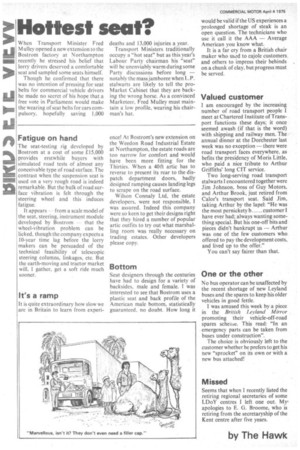Fatigue on hand
Page 32

If you've noticed an error in this article please click here to report it so we can fix it.
The seat-testing rig developed by Bostrom at a cost of some £15,000 provides erstwhile buyers with simulated road tests of almost any conceivable type of road surface. The contrast when the suspension seat is used on a very rough road is indeed remarkable. But the bulk of road surface vibration is felt through the steering wheel and this induces fatigue.
It appears from a scale model of the seat, steering, instrument module developed by Bostrom — that the wheel-vibration problem can be licked, though the company expects a 10-year time lag before the lorry makers can be persuaded of the technical feasibility of telescopic steering columns, linkages, etc. But the earth-moving and tractor market will, I gather, get a soft ride much sooner.
It's a ramp
It is quite extraordinary how slow we are in Britain to learn from experi ence! At Bostrom's new extension on the Weedon Road Industrial Estate at Northampton, the estate roads are too narrow for comfort and would have been more fitting for the Thirties. When a 40ft artic has to reverse to present its rear to the dispatch department doors, badly designed ramping causes landing legs to scrape on the road surface.
Wilson Connaly Ltd, the estate developers, were not responsible, I was assured. Indeed this company were so keen to get their designs right that they hired a number of popular artic outfits to try out what marshalling room was really necessary on trading estates. Other developers please copy.
Bottom
Seat designers through the centuries have had to design for a variety of backsides, male and female. I was interested to see that Bostrom uses a plastic seat and back profile of the American male bottom, statistically guaranteed, no doubt. How long it would be valid if the US experiences a prolonged shortage of steak is an open question. The technicians who use it call it the AAA — Average American you know what.
It is a far cry from a British chair maker who uszd to cajole customers, and others to impress their behinds on a chunk of clay, but progress must be served.
Valued customer
I am encouraged by the increasing number of road transport people I meet at Chartered Institute of Transport functions these days; it once seemed awash (if that is the word) with shipping and railway men. The annual dinner at the Dorchester last week was no exception — there were road transport faces everywhere, as befits the presidency of Moris Little, who paid a nice tribute to Arthur Griffiths' long CIT service.
Two long-serving road transport stalwarts I encountered together were Jim Johnson, boss of Guy Motors, and Arthur Brook, just retired from Calor's transport seat. Said Jim, taking Arthur by the lapel: "He was the most pernickety b customer I have ever had; always wanting something special. But his one-off bits and pieces didn't bankrupt us — Arthur was one of the few customers who offered to pay the development costs, and lived up to the offer."
You can't say fairer than that.
One or the other
No bus operator can be unaffected by the recent shortage of new Leyland buses and the spares to keep his older vehicles in good fettle.
I was amused this week by a piece in the British Leyland Mirror promoting their vehicle-off-road spares schen/e. This read: "In an emergency parts can be taken from buses under construction".
The choice is obviously left to the customer whether he prefers to get his new "sprocket" on its own or with a new bus attached!
Missed
Seems that when I recently listed the retiring regional secretaries of some LDoY centres I left one out. My, apologies to E. G. Broome, who is retiring from the secretaryship of the Kent centre after five years.
by The Hawk




































































































